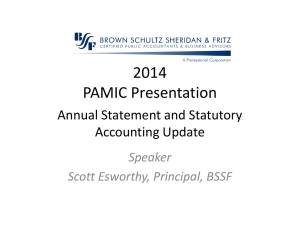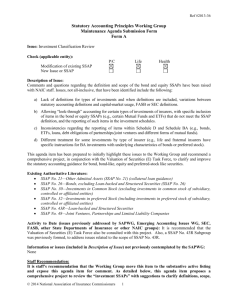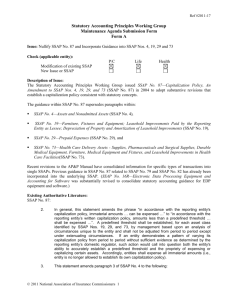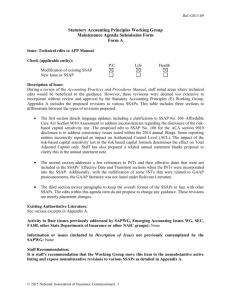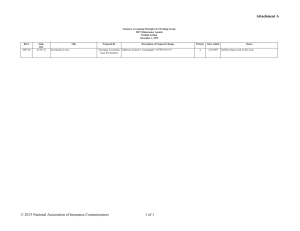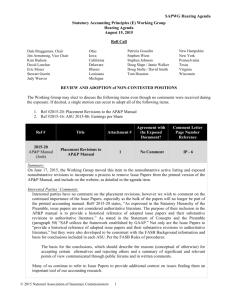2015-33 - National Association of Insurance Commissioners
advertisement
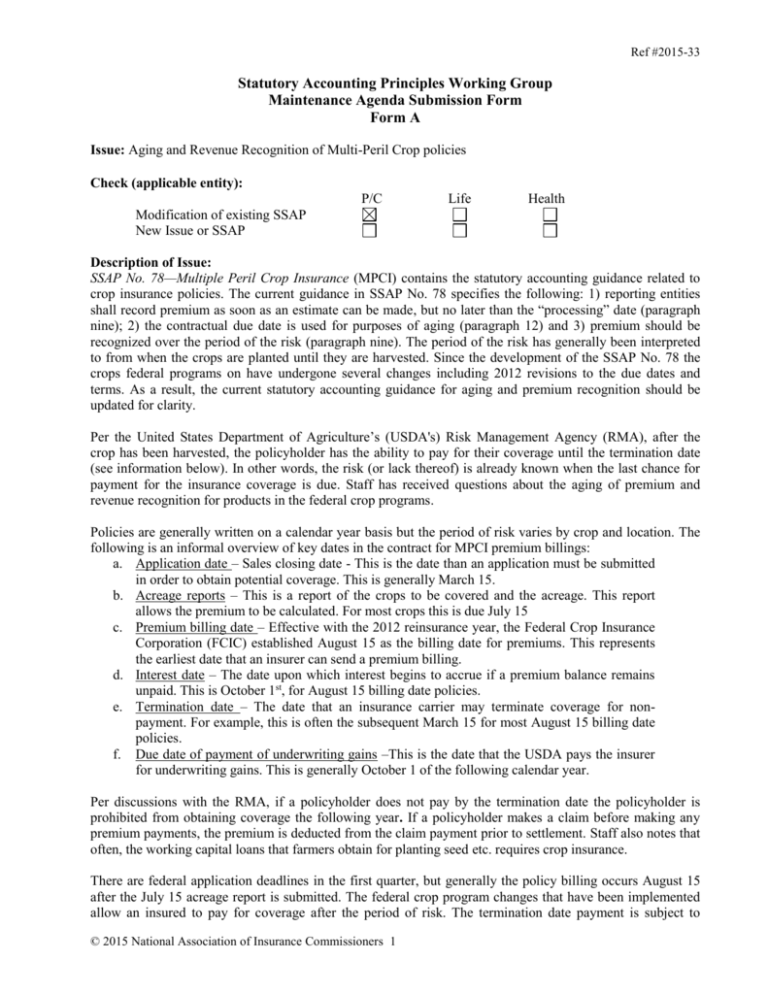
Ref #2015-33 Statutory Accounting Principles Working Group Maintenance Agenda Submission Form Form A Issue: Aging and Revenue Recognition of Multi-Peril Crop policies Check (applicable entity): P/C Life Health Modification of existing SSAP New Issue or SSAP Description of Issue: SSAP No. 78—Multiple Peril Crop Insurance (MPCI) contains the statutory accounting guidance related to crop insurance policies. The current guidance in SSAP No. 78 specifies the following: 1) reporting entities shall record premium as soon as an estimate can be made, but no later than the “processing” date (paragraph nine); 2) the contractual due date is used for purposes of aging (paragraph 12) and 3) premium should be recognized over the period of the risk (paragraph nine). The period of the risk has generally been interpreted to from when the crops are planted until they are harvested. Since the development of the SSAP No. 78 the crops federal programs on have undergone several changes including 2012 revisions to the due dates and terms. As a result, the current statutory accounting guidance for aging and premium recognition should be updated for clarity. Per the United States Department of Agriculture’s (USDA's) Risk Management Agency (RMA), after the crop has been harvested, the policyholder has the ability to pay for their coverage until the termination date (see information below). In other words, the risk (or lack thereof) is already known when the last chance for payment for the insurance coverage is due. Staff has received questions about the aging of premium and revenue recognition for products in the federal crop programs. Policies are generally written on a calendar year basis but the period of risk varies by crop and location. The following is an informal overview of key dates in the contract for MPCI premium billings: a. Application date – Sales closing date - This is the date than an application must be submitted in order to obtain potential coverage. This is generally March 15. b. Acreage reports – This is a report of the crops to be covered and the acreage. This report allows the premium to be calculated. For most crops this is due July 15 c. Premium billing date – Effective with the 2012 reinsurance year, the Federal Crop Insurance Corporation (FCIC) established August 15 as the billing date for premiums. This represents the earliest date that an insurer can send a premium billing. d. Interest date – The date upon which interest begins to accrue if a premium balance remains unpaid. This is October 1st, for August 15 billing date policies. e. Termination date – The date that an insurance carrier may terminate coverage for nonpayment. For example, this is often the subsequent March 15 for most August 15 billing date policies. f. Due date of payment of underwriting gains –This is the date that the USDA pays the insurer for underwriting gains. This is generally October 1 of the following calendar year. Per discussions with the RMA, if a policyholder does not pay by the termination date the policyholder is prohibited from obtaining coverage the following year. If a policyholder makes a claim before making any premium payments, the premium is deducted from the claim payment prior to settlement. Staff also notes that often, the working capital loans that farmers obtain for planting seed etc. requires crop insurance. There are federal application deadlines in the first quarter, but generally the policy billing occurs August 15 after the July 15 acreage report is submitted. The federal crop program changes that have been implemented allow an insured to pay for coverage after the period of risk. The termination date payment is subject to © 2015 National Association of Insurance Commissioners 1 Ref #2015-33 interest but it allows the payment to activate the policy if application and acreage reports have been submitted for the prior period even though the crop has been harvested and is not at risk. Existing Authoritative Literature: SSAP No. 78 provides the following (bolding added for emphasis): Premium Recognition 7. MPCI gross premium is defined as the contractually determined amount specified by FCIC to the policyholder for the effective period of the contract based on the actuarially determined expectation of risk and policy benefits associated with the coverage provided by the terms of the insurance contract. In addition, gross premium shall also include the government premium subsidy paid on behalf of the policyholder. 8. MPCI ceded premium and losses are defined as the amount calculated by applying the proportional and non-proportional factors as stated in the SRA. An example of this application is shown in Exhibit A to this statement. 9. MPCI written premium shall be recorded as soon as an estimate can be made, but no later than the processing date. Upon recording written premium, a liability for the unearned premium reserve shall be established to reflect the amount of premium for the portion of the insurance coverage that has not yet expired. Premiums shall be recognized as revenue over the period of risk in proportion to the amount of insurance protection provided. 10. The company shall disclose the method used to compute the unearned premium reserve in the financial statements. Amounts Receivable or Payable 11. The company shares underwriting risk with FCIC and can earn or lose money according to the claims it must pay farmers for crop losses. The company earns underwriting profits when the net retained premiums exceed the net crop loss claims paid. The company incurs underwriting losses when the net claims paid for crop losses exceed the net retained premiums. These definitions do not consider underwriting expenses, which would be included for traditional statutory accounting underwriting gains and losses. The use of the terms underwriting gains and losses in this issue paper are unique to the MPCI program. As the premiums of the program are held by FCIC in escrow, the company shall recognize as a write-in asset a receivable from FCIC for the amount of the underwriting gain (as defined in this paragraph). Whereas, when the company is in an underwriting loss position, the company shall recognize a write-in liability to the FCIC for the amount of the underwriting loss (as defined in this paragraph), as the monies held in the escrow account are not sufficient to cover the company’s claims. In accordance with the SRA, funds that remain in escrow will be distributed to the company at the conclusion of the contract period if the contract results in a gain to the company. If the company owes additional funds to the escrow (i.e., it is in a loss position), those funds are remitted on a periodic basis until the contract expires. These amounts shall be recorded net as the program meets the requirements of offsetting as defined in SSAP No. 64— Offsetting and Netting of Assets and Liabilities (SSAP No. 64). In accordance with SSAP No. 21— Other Admitted Assets (SSAP No. 21), the amount receivable under the Federal Crop Insurance program shall be reported as an admitted asset. 12. Amounts receivable from policyholders meet the definition of an admitted asset as set forth in SSAP No. 4—Assets and Nonadmitted Assets (SSAP No. 4) and should be accounted for in accordance with SSAP No. 6—Uncollected Premium Balances, Bills Receivable for Premiums, and Amounts Due From Agents and Brokers (SSAP No. 6). The due date shall be governed by contractual due date of the premium billing, and not the effective date of the contract. Activity to Date (issues previously addressed by SAPWG, Emerging Accounting Issues WG, SEC, FASB, other State Departments of Insurance or other NAIC groups): None © 2015 National Association of Insurance Commissioners 2 Ref #2015-33 Information or issues (included in Description of Issue) not previously contemplated by the SAPWG: None Staff Recommendation: SSAP No. 78, paragraph 12 is specific that the billing date (generally August 15 for a calendar year policy), is used for application of the 90-day rule, therefore, premium that is unpaid 90 days after the billing date should be nonadmitted until received. NAIC staff has learned that there is diversity in practice regarding the date used for application of the 90-day rule. Additionally, it has been identified that the term “processing date” in paragraph 9 should be further defined or the term should be updated. Staff is aware that there is diversity in practice in earning premium for the period of risk and suggests the guidance should be more specific. It is staff’s recommendation that the Working Group move this item to the nonsubstantive active listing and request comments from regulators, industry, and the RMA regarding the intent to develop clarifying language regarding: 1) The use of the billing date for application of the 90-day rule; 2) Defining the processing date in paragraph 9 or updating the term; 3) Providing more specificity regarding the period of risk for purposes of earning revenue; and 4) Developing a glossary of terms including dates that are specific to the federal crop programs. 5) If there is a perceived need to update other aspects of SSAP No. 78. In addition, the Working Group should formally notify the Crop Insurance (C) Working Group of their intent to update the relevant guidance in SSAP No. 78. After receiving comments, the Working Group might consider if forming an informal drafting group to review proposed changes would be productive. Depending on the degree of changes contemplated, the Working Group could revisit the decision to classify this item as “nonsubstantive.” Staff Review Completed by: Robin Marcotte – July 7, 2015 NAIC staff Status: On August 15, 2015, the Statutory Accounting Principles (E) Working Group moved this item to the nonsubstantive active listing and exposed this agenda item to collect information from regulators, industry, and the USDA Risk Management Agency (RMA) regarding any needed updates to SSAP No. 78 and the intent to develop clarifying language on the items identified in the above staff recommendation. In addition, the Working Group directed staff to formally notify the Crop Insurance (C) Working Group of the request for comments and the Statutory Accounting Principles (E) Working Group intent to update the relevant guidance in SSAP No. 78. G:\DATA\Stat Acctg\3. National Meetings\A. National Meeting Materials\2015\Summer\NM Exposures\15-33 SSAP 78 Crop Hail aging.docx © 2015 National Association of Insurance Commissioners 3







